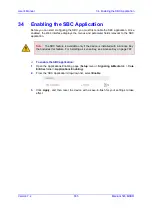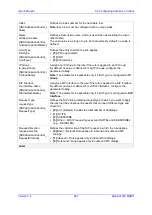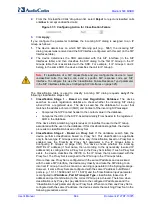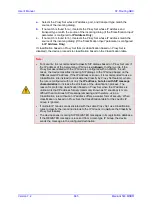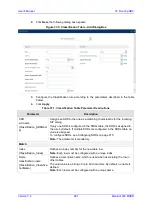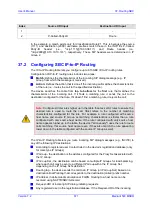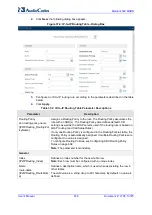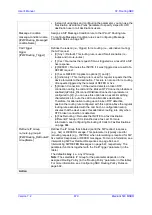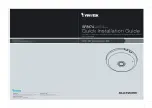
User's Manual
664
Document #: LTRT-10375
Mediant 500 MSBR
2.
From the 'Unclassified Calls' drop-down list, select
Reject
to reject unclassified calls
or
Allow
to accept unclassified calls:
Figure
37-1: Configuring Action for Classification Failure
3.
Click
Apply
.
If you configure the parameter to
Allow
, the incoming SIP dialog is assigned to an IP
Group as follows:
1.
The device determines on which SIP listening port (e.g., 5061) the incoming SIP
dialog request was received and the SIP Interface configured with this port (in the SIP
Interfaces table).
2.
The device determines the SRD associated with this SIP Interface (in the SIP
Interfaces table) and then classifies the SIP dialog to the first IP Group in the IP
Groups table that is associated with the SRD. For example, if IP Groups 3 and 4
belong to the same SRD, the device classifies the call to IP Group 3.
Note:
If classification of a SIP request fails and you configure the device to reject
unclassified calls, the device can send a specific SIP response code per SIP
Interface. To configure this, use the 'Classification Failure Response Type' parameter
in the SIP Interfaces table (see Configuring SIP Interfaces on page 325).
The Classification table is used to classify incoming SIP dialog requests
only if
the
following classification stages fail:
1.
Classification Stage 1 - Based on User Registration Database:
The device
searches its users registration database to check whether the incoming SIP dialog
arrived from a registered user. The device searches the database for a user that
matches the address-of-record (AOR) and Contact of the incoming SIP message:
•
Compares the SIP Contact header to the contact value in the database.
•
Compares the URL in the SIP P-Asserted-Identity/From header to the registered
AOR in the database.
If the device finds a matching registered user, it classifies the user to the IP Group
associated with the user in the database. If this classification stage fails, the device
proceeds to classification based on Proxy Set.
2.
Classification Stage 2 - Based on Proxy Set:
If the database search fails, the
device performs classification based on Proxy Set. This classification is applicable
only to Server-type IP Groups and is done only if classification based on Proxy Set is
enabled (see the 'Classify By Proxy Set' parameter in the IP Groups table in
Configuring IP Groups on page 333). The device checks whether the incoming
INVITE's IP address (if host name, then according to the dynamically resolved IP
address list) is configured for a Proxy Set (in the Proxy Sets table). If such a Proxy Set
exists, the device classifies the INVITE to the IP Group that is associated with the
Proxy Set. The Proxy Set is assigned to the IP Group in the IP Groups table.
If more than one Proxy Set is configured with the same IP address and associated
with the same SIP Interface, the device may classify and route the SIP dialog to an
incorrect IP Group. In such a scenario, a warning is generated in the Syslog message.
However, if some Proxy Sets are configured with the same IP address but different
ports (e.g., 10.1.1.1:5060 and 10.1.1.1:5070) and the 'Classification Input' parameter
is configured to
IP Address, Port & Transport Type
, classification (based on IP
address and port combination) to the correct IP Group is achieved. Therefore, when
classification is by Proxy Set, pay attention to the configured IP addresses and the
'Classification Input' parameter of your Proxy Sets. When more than one Proxy Set is
configured with the same IP address, the device selects the matching Proxy Set in the
following precedence order:
Summary of Contents for Mediant 500 MSBR
Page 2: ......
Page 33: ...Part I Getting Started with Initial Connectivity ...
Page 34: ......
Page 36: ...User s Manual 36 Document LTRT 10375 Mediant 500 MSBR This page is intentionally left blank ...
Page 40: ...User s Manual 40 Document LTRT 10375 Mediant 500 MSBR This page is intentionally left blank ...
Page 45: ...Part II Management Tools ...
Page 46: ......
Page 48: ...User s Manual 48 Document LTRT 10375 Mediant 500 MSBR This page is intentionally left blank ...
Page 115: ...Part III General System Settings ...
Page 116: ......
Page 132: ...User s Manual 132 Document LTRT 10375 Mediant 500 MSBR This page is intentionally left blank ...
Page 137: ...Part IV General VoIP Configuration ...
Page 138: ......
Page 290: ...User s Manual 290 Document LTRT 10375 Mediant 500 MSBR This page is intentionally left blank ...
Page 306: ...User s Manual 306 Document LTRT 10375 Mediant 500 MSBR This page is intentionally left blank ...
Page 380: ...User s Manual 380 Document LTRT 10375 Mediant 500 MSBR This page is intentionally left blank ...
Page 454: ...User s Manual 454 Document LTRT 10375 Mediant 500 MSBR This page is intentionallty left blank ...
Page 455: ...Part V Gateway Application ...
Page 456: ......
Page 460: ...User s Manual 460 Document LTRT 10375 Mediant 500 MSBR This page is intentionally left blank ...
Page 484: ...User s Manual 484 Document LTRT 10375 Mediant 500 MSBR This page is intentionally left blank ...
Page 494: ...User s Manual 494 Document LTRT 10375 Mediant 500 MSBR This page is intentionally left blank ...
Page 625: ...Part VI Session Border Controller Application ...
Page 626: ......
Page 654: ...User s Manual 654 Document LTRT 10375 Mediant 500 MSBR This page is intentionally left blank ...
Page 656: ...User s Manual 656 Document LTRT 10375 Mediant 500 MSBR This page is intentionally left blank ...
Page 741: ...Part VII Cloud Resilience Package ...
Page 742: ......
Page 751: ...Part VIII Data Router Configuration ...
Page 752: ......
Page 753: ......
Page 754: ......
Page 756: ...User s Manual 756 Document LTRT 10375 Mediant 500 MSBR This page is intentionally left blank ...
Page 757: ...Part IX Maintenance ...
Page 758: ......
Page 834: ...User s Manual 834 Document LTRT 10375 Mediant 500 MSBR This page is intetnionaly left blank ...
Page 837: ...Part X Status Performance Monitoring and Reporting ...
Page 838: ......
Page 848: ...User s Manual 848 Document LTRT 10375 Mediant 500 MSBR This page is intentionally left blank ...
Page 852: ...User s Manual 852 Document LTRT 10375 Mediant 500 MSBR This page is intentionally left blank ...
Page 854: ...User s Manual 854 Document LTRT 10375 Mediant 500 MSBR This page is intentionally left blank ...
Page 878: ...User s Manual 878 Document LTRT 10375 Mediant 500 MSBR This page is intentionally left blank ...
Page 880: ...User s Manual 880 Document LTRT 10375 Mediant 500 MSBR This page is intentionally left blank ...
Page 926: ...User s Manual 926 Document LTRT 10375 Mediant 500 MSBR This page is intentionally left blank ...
Page 927: ...Part XI Diagnostics ...
Page 928: ......
Page 950: ...User s Manual 950 Document LTRT 10375 Mediant 500 MSBR This page is intentionally left blank ...
Page 954: ...User s Manual 954 Document LTRT 10375 Mediant 500 MSBR This page is intentionally left blank ...
Page 956: ...User s Manual 956 Document LTRT 10375 Mediant 500 MSBR This page is intentionally left blank ...
Page 958: ...User s Manual 958 Document LTRT 10375 Mediant 500 MSBR This page is intentionally left blank ...
Page 974: ...User s Manual 974 Document LTRT 10375 Mediant 500 MSBR This page is intentionally left blank ...
Page 976: ...User s Manual 976 Document LTRT 10375 Mediant 500 MSBR This page is intentionally left blank ...
Page 977: ...Part XII Appendix ...
Page 978: ......
Page 982: ...User s Manual 982 Document LTRT 10375 Mediant 500 MSBR This page is intentionally left blank ...






